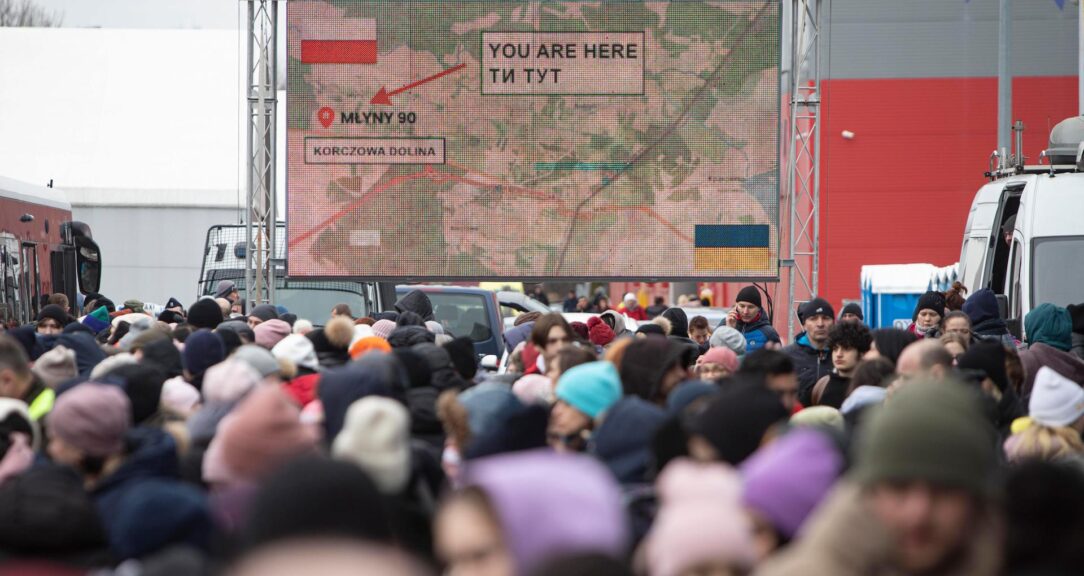In Ukraine, everything changed the morning of 24 February 2022. As the invasion became a reality, hundreds of thousands of people began to flee.
But one of Ukraine’s largest payroll providers, EBS, was prepared. A local ADP partner since 2009, the company knew payroll continuity would be crucial to Ukrainians trying to relocate or otherwise navigate the crisis.
“In the first hours of the invasion, we realized that running payroll was part of our social responsibility,” says Marina Makarenko, Partner and Payroll Outsourcing Practice Leader at EBS. “Seeing people behind payroll figures is what keeps you engaged and focused even under air raids.”
As the battle for control of Ukraine’s capital, Kyiv, continued throughout the late winter and spring, the knowledge that many Ukranians lived month-to-month with limited savings — making them particularly reliant on their paychecks — gave the EBS team motivation and purpose in a difficult situation, Makarenko adds. Getting people paid was crucial to both individuals’ survival and the Ukrainian economy as a whole.
In the early days of the invasion, there was a clear difference between businesses that had planned and those that hadn’t, Makarenko says. The ones that had business continuity plans in place made decisions much more quickly — decisions that weren’t guided by fear or panic — whereas others are still struggling more than a year later.
Hope for the best, prepare for the worst
Business continuity plans (BCPs) outline how a business will keep operating even in the case of unplanned or severe service disruptions.
As tensions escalated in early 2022, many companies — particularly tech companies and multinationals — reviewed and updated existing BCPs, even as they hoped that a ground invasion would remain a remote possibility. Cyber attacks against businesses seemed more imminent, as government websites, state-owned banks and national infrastructure were hit by hackers.
According to one consulting firm, most organizations the firm worked with either didn’t have plans in place or had plans that had to be scrapped because they addressed the wrong scenarios. Historically, most BCPs have planned for natural disasters, terrorism, infrastructure fall out and fraud. In Ukraine, some global business services leaders said they moved their BCPs from the drawer to the trash can.
But other companies, such as EBS, which serves more than 250 clients, had developed more comprehensive BCPs following the Crimean crisis in 2014.
As part of its plan, EBS prepared contingency plans for each client, which the company uploaded to the client portal, and worked with third parties such as banks and technical support offices to develop and agree to the business continuity plan. The company also set up additional cloud storage outside Ukraine, eventually creating a second active mirror data center that was a full replica of the server in Kyiv, and communicated the plan to staff.
“We ran all different scenarios to know how to support our people and clients if anything happened,” Makarenko says.
EBS left it up to individual employees to decide whether to stay in Kyiv or relocate to safer areas in Western Ukraine or abroad. About 80% of employees left the capital, and EBS activated flexible work policies that it had developed in response to the Covid-19 pandemic. Later, the company installed Starlink satellite internet to ensure they stayed connected and payroll processing could continue.
The plan needed to constantly evolve, Makarenko says. BCPs are a “living continuum” that exist in response to a constantly changing environment. “Having one plan isn’t actually enough and having the plan just on paper is not enough,” she says. “It has to be a real acting plan that has to be constantly updated depending on the change in circumstances.”
BCPs are typically designed by a staff team led by the company’s risk manager, according to consultants. In the case of armed conflict, the head of a location drives the execution. The situation in Ukraine demonstrated that it can be impossible to predict what disruptions will arise, making it important to “friend-shore,’” or relocate supply chains to countries where the risk of political chaos and disruption is low. For example, many companies are now relying more heavily on products and services located within the E.U.
Putting the plan to work
Business continuity plans such as EBS’s have proven crucial to weathering the economic impact of geo-political conflict. Ukraine’s economy shrank by one-third last year, and the Kyiv School of Economics estimates the country had sustained $138 billion in damage to infrastructure as of December. An August 2022 survey of 20,000 workers in Ukraine found 30% had had their roles downsized or been laid off. Many companies that were previously looking to set up operations in Ukraine have put their plans on hold for now.
The situation, however, appears to be stabilizing. In the same survey, 33% of employees reported they had returned to work after their companies initially suspended operations. The economic ministry is forecasting 3.2% growth in GDP this year, Reuters reports.
Many of the companies facing the biggest hurdles operate in energy-intensive fields such as steel manufacturing, which don’t lend themselves to straightforward solutions such as backup generators — a common feature of Ukrainian BCPs.
BCPs are not a one-size-fits-all solution. As a starting point, companies should understand the specific threats they face and rank those threats based on their likelihood and potential impact on operations, according to ADP’s risk analysts. It doesn’t take a full-blown invasion to devastate business networks; a simple power outage can have serious consequences.
Each plan should include a list of key contacts for employees, with a designated person (and back-up) assigned to oversee the BCP. Businesses should know in advance how they will communicate with staff, suppliers and customers if systems go down, and should have a way to contact IT service providers in the case of systems failure. They should also have backups of all critical files and know in advance what their insurance policies cover. Today, policies exist specifically for business interruptions and cyber attacks.
Companies also need a clear plan for paying employees, who often face added costs stemming from disasters. Whether those costs are small, like the price of bottled water, or large, like rebuilding or relocating: helping employees recover is key to organizational success. Paycards and direct deposits are often a good way to ensure employees can access their pay, since banks typically have strong contingency plans for operating in disaster situations.
In Ukraine, EBS’s payroll continuity efforts paid off. “Today we’re proud to say we didn’t have a single processing failure,” Makarenko says. “What’s even more important is that the confidentiality and integrity of our clients’ data has been preserved.”
And in the face of crisis, the company has another reason to be hopeful: It has onboarded six new clients since January.
Watch EBS share their story at the ADP ReThink 2023 event:
Read more
Sign up to keep up to date with ReThink Q.






